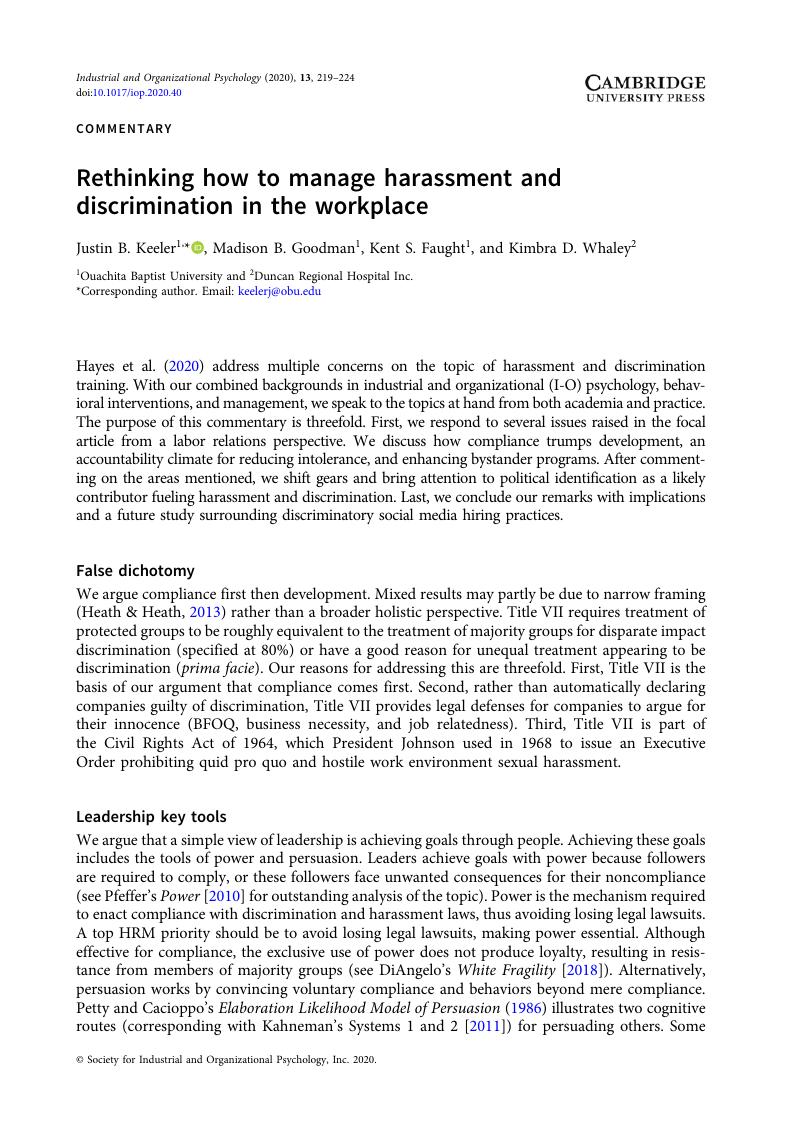No CrossRef data available.
Article contents
Rethinking how to manage harassment and discrimination in the workplace
Published online by Cambridge University Press: 28 July 2020
Abstract
An abstract is not available for this content so a preview has been provided. Please use the Get access link above for information on how to access this content.

- Type
- Commentaries
- Information
- Copyright
- © Society for Industrial and Organizational Psychology, Inc. 2020
References
Coker, A. L., Bush, H. M., Cook-Craig, P. G., DeGue, S. A., Clear, E. R., Brancato, C. J., Fisher, B. S., & Recktenwald, E. A. (2017). RCT testing bystander effectiveness to reduce violence. American Journal of Preventive Medicine, 52(5), 566–578. doi: 10.1016/j.amepre.2017.01.020CrossRefGoogle ScholarPubMed
Culwell, A. C. (2018). How leaders can strengthen their organizational culture. Stanford Social Innovation Review. https://ssir.org/articles/entry/how_leaders_can_strengthen_their_organizational_cultureGoogle Scholar
DiAngelo, R. (2018). White fragility: Why it’s so hard for white people to talk about racism. Boston, MA: Beacon Press.Google Scholar
Gentile, M. C. (2010). Giving voice to values: How to speak your mind when you know what’s right. New Haven, CT: Yale University Press.Google Scholar
Hayes, T. L., Kaylor, L. E., & Oltman, K. A. (2020). Coffee and controversy: How applied psychology can revitalize sexual harassment and racial discrimination training. Industrial and Organizational Psychology: Perspectives on Science and Practice, 13(2), XXX–XXX. doi: 10.107/iop.2019.84CrossRefGoogle Scholar
Heath, C., & Heath, D. (2013). Decisive: How to make better choices in life and work. New York, NY: Random House.Google Scholar
Jost, J. T., Banaji, M. R., & Nosek, B. A. (2004). A decade of system justification theory: Accumulated evidence of conscious and unconscious bolstering of the status quo. Political Psychology, 25(6), 881–919. doi: 10.1111/j.1467-9221.2004.00402.xCrossRefGoogle Scholar
Katz, J., Heisterkamp, H. A., & Fleming, W. M. (2011). The social justice roots of the mentors in violence prevention model and its application in a high school setting. Violence Against Women, 17(6), 684–702. doi: 10.1177/1077801211409725CrossRefGoogle Scholar
Kelly, M., & Wilkinson, L. (2018). Implementing the green dot bystander intervention program to promote respectful workplaces in the construction trades in Oregon. NITC-RR1078. Portland, OR: Transportation Research and Education Center (TREC). doi: 10.15760/trec.206CrossRefGoogle Scholar
LeBlanc, L. A., Coates, A. M., Daneshvar, S., Charlop-Christy, M. H., Morris, C., & Lancaster, B. M. (2003). Using video modeling and reinforcement to teach perspective-taking skills to children with autism. Journal of Applied Behavior Analysis, 36(2), 253–257. doi: 10.1901/jaba.2003.36-253CrossRefGoogle ScholarPubMed
Madera, J. M., Neal, J. A., & Dawson, M. (2011). A strategy for diversity training: Focusing on empathy in the workplace. Journal of Hospitality & Tourism Research, 35(4), 469–487. doi: 10.1177/1096348010382240CrossRefGoogle Scholar
Markman, A. (2014, October 31). Coworkers should be like neighbors, not like family. Harvard Business Review. https://hbr.org/2014/10/coworkers-should-be-like-neighbors-not-like-familyGoogle Scholar
Petty, R. E., & Cacioppo, J. T. (2012). Communication and persuasion: Central and peripheral routes to attitude change. Springer Science & Business Media.Google Scholar
Pfeffer, J. (1986). The elaboration likelihood model of persuasion. In Communication and persuasion (pp. 1–24). New York, NY: Springer.Google Scholar
Potter, S. J. (2012). Using a multimedia social marketing campaign to increase active bystanders on the college campus. Journal of American College Health, 60(4), 282–295. doi: 10.1080/07448481.2011.599350CrossRefGoogle ScholarPubMed
Prochaska, J. O., & DiClemente, C. C. (1986). Toward a comprehensive model of change. In Miller, W. R. & Heather, N. (Eds.), Treating addictive behaviors (pp. 3–27). Springer. doi: 10.1007/978-1-4613-2191-0_1CrossRefGoogle Scholar
Rubin, M., & Hewstone, M. (2004). Social identity, system justification, and social dominance: Commentary on Reicher, Jost et al., and Sidanius et al. Political Psychology, 25(6), 823–844. doi: 10.1111/j.1467-9221.2004.00400.xCrossRefGoogle Scholar
Schulte, B. (2018, October 31). To combat harassment, more companies should try bystander training. Harvard Business Review. https://hbr.org/2018/10/to-combat-harassment-more-companies-should-try-bystander-trainingGoogle Scholar
Tawa, J. (2017). “Walk a mile in my shoes”: A virtual world exercise for fostering students’ subjective understanding of the experiences of people of color. In Ma, M. & Oikonomou, A (Eds.), Serious games and edutainment applications (Vol. 2). Cham, Switzerland: Springer. doi: 10.1007/978-3-319-51645-5_17Google Scholar
Tippett, E. C. (2018). Harassment trainings: A content analysis. Berkeley Journal of Employment & Labor Law, 39, 481–526. doi: 10.15779Z38WP9T69MGoogle Scholar
Williams, S., & Aldred, A. (2011). Change making: How we adopt new attitudes, beliefs and practices. https://policy-practice.oxfam.org.uk/publications/change-making-how-we-adopt-new-attitudes-beliefs-and-practices-145255Google Scholar


